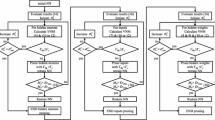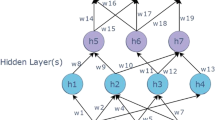Abstract
In traditional neural trees (NTs), each internal node is designed as a neural network (NN), such as single- or two-layer neural networks, to determine which branch should be followed for an input sample. Because each NN contained in the internal nodes is designed separately, the produced NT does not consider overall effectiveness. Thus, the designed NT is usually not an optimal NT. In this study, the tree-structured multilayer neural network (TSMLNN) is proposed for classification. The TSMLNN is similar to an NT, which is the result of dividing a deep multilayer NN into many small sub-networks. The TSMLNN has the advantages of both a multilayer NN and an NT. In addition, the split method is proposed to determine how to split the network in the TSMLNN. The genetic algorithm is proposed to automatically search for the weights, activation threshold of each node and the proper number of nodes at each layer according to both the computing complexity and classification error rate in the TSMLNN, and the proposed TSMLNN tends to be optimal. A heuristic method is also proposed to help users to decide which TSMLNN is the best within the classification error rate range. Finally, the performance of the proposed TSMLNN is compared with that of state-of-the-art neural networks in experiments.










Similar content being viewed by others
References
Reza T, Mohammadreza K (2018) A method for handwritten word spotting based on particle swarm optimization and multi-layer perceptron. IET Softw 12(2):152–159
Sudholt S, Fink GA (2016) A deep convolutional neural network for word spotting in handwritten documents. In: 15th international conference frontiers in handwriting recognition (ICFHR), Shenzhen, China, pp 277–282
Khayyat M, Lam L, Suen CY (2014) Learning-based word spotting system for Arabic handwritten documents. Pattern Recogn 47(3):1021–1030
Xu Y et al (2015) A regression approach to speech enhancement based on deep neural networks. IEEE Trans Audio Speech Lang Process 23(1):7–19
Zagoris K, Pratikakis I, Gatos B (2017) Unsupervised word spotting in historical handwritten document images using document-oriented local features. IEEE Trans Image Process 26(8):4032–4041
Toselli AH, Puigcerver J, Vidal E (2016) Two methods to improve confidence scores for Lexicon-free word spotting in handwritten text. In: 15th international conference frontiers in handwriting recognition (ICFHR), Shenzhen, China, pp 349–354
Siniscalchi SM et al (2014) An artificial neural network approach to automatic speech processing. Neurocomputing 140(22):326–338
Luca B, Henriques JF, Valmadre J, Torr P, Vedaldi A (2016) Learning feed-forward one-shot learners. In Advances in NIPS, pp 523–531
Dong C, Loy CC, He K, Tang X (2016) Image super-resolution using deep convolutional networks. IEEE Trans Pattern Anal Mach Intell 38(2):295–307
Kim J, Kwon Lee J, Mu Lee K (2016) Accurate image super-resolution using very deep convolutional networks. In: Proceedings of the IEEE conference on computer vision and pattern recognition, pp 1646–1654
Zang F, Du B, Zhang L, Xu M (2016) Weakly supervised learning based on coupled convolutional neural networks for aircraft detection. IEEE Trans Geosci Remote Sens 54(9):53–63
Larochelle H (2009) Exploring strategies for training deep neural networks. Mach Learn 1:1–40
Hinton G et al (2012) Deep neural networks for acoustic modeling in speech recognition: the shared views of four research groups. IEEE Signal Process Mag 29(6):82–97
Lu X et al (2013) Speech enhancement based on deep denoising autoencoder. In: Proceedings of Interspeech, pp 436–440
Simard PY et al (2003) Best practices for convolutional neural networks applied to visual document analysis. In: Proceedings of international conference on document analysis and recognition, pp 958–963
Ciresan D et al (2012) Multi-column deep neural networks for image classification. In: Proceedings of annual conference on computer vision and pattern recognition, pp 3642–3649
Chen TE, Yang SI, Ho LT, Tsai KH, Chen YH, Chang YF, Lai YH, Wang SS, Tsao Y, Wu CC (2017) S1 and S2 heart sound recognition using deep neural networks. IEEE Trans Biomed Eng 64(2):372–380
Zhang H, Chow TWS, Jonathan Wu QM (2016) Organizing books and authors by multilayer SOM. IEEE Trans Neural Netw Learn Syst 27(12):2537–2550
Zhang H, Wang S, Xu X, Chow TWS, Jonathan Wu QM (2018) Tree2Vector: learning a vectorial representation for tree-structured data. IEEE Trans Neural Netw Learn Syst 29(11):5304–5318
Zhang H, Wang S, Zhao M, Xu X, Ye Y (2018) Locality reconstruction models for book representation. IEEE Trans Knowl Data Eng 30(10):1873–1886
Guo H, Gelfand SB (1992) Classification trees with neural networks feature extraction. IEEE Trans Neural Netw 3(6):923–933
Foresti GL, Micheloni C (2002) Generalized neural trees for pattern classification. IEEE Trans Neural Netw 13(6):1540–1547
Foresti GL (2004) An adaptive high-order neural tree for pattern recognition. IEEE Trans Syst Man Cybern Part B Cybern 34(2):988–996
Maji P (2008) Efficient design of neural network tree using a single splitting criterion. Nerocomputing 71:787–800
Micheloni C, Rani A, Kumarb S, Foresti GL (2012) A balanced neural tree for pattern classification. Neural Netw 27:81–90
Balestriero R (2017) Neural decision trees, 1–11. arXiv:1702.07360v2
Yang SB (2018) Constrained-storage variable-branch neural tree for classification. Neural Comput Appl. https://doi.org/10.1007/s00521-017-3315-y
Mahmoudabadi H, Izadi M, Menhaj MB (2009) A hybrid method for grade estimation using genetic algorithm and neural networks. Comput Geosci 13:91–101
Samanta B, Bandopadhyay S, Ganguli R (2004) Data segmentation and genetic algorithms for sparse data division in Nome placer gold grade estimation using neural network and geostatistics. Min Explor Geol 11(1):69–76
Chatterjee S, Bandopadhyay S, Machuca D (2010) Ore grade prediction using a genetic algorithm and clustering based ensemble neural network model. Math Geosci 42(3):309–326
Tahmasebi P, Hezarkhani A (2009) Application of optimized neural network by genetic algorithm. IAMG09. Stanford University; California, 2(2):15–23
David OE, Greental I (2014) Genetic algorithms for evolving deep neural networks. GECCO’14, pp 12–16
Le Borgne H, Guérin-Dugué A, O’Connor NE (2007) Learning midlevel image features for natural scene and texture classification. IEEE Trans Circuits Syst Video Technol 17(3):286–297
Gonzalez RC, Woods RE (1992) Digital image processing. Addison-Wesley, Boston
Simonyan K, Zisserman A (2015) Very deep convolutional networks for large-scale image recognition. arXiv:1409.1556
Szegedy C, Liu W, Jia Y, Sermanet P, Reed S, Anguelov D, Erhan D, Vanhoucke V, Rabinovich A (2015) Going deeper with convolutions. arXiv:1409.4842
He K, Zhang X, Ren S, Sun J (2015) Deep residual learning for image recognition. arXiv:1512.03385
He K, Zhang X, Ren S, Sun J (2015) Delving deep into rectifiers: Surpassing human-level performance on imagenet classification. arXiv:1502.01852
Ioffe S, Szegedy C (2015) Batch normalization: accelerating deep network training by reducing internal covariate shift. arXiv:1502.03167
Russakovsky O, Deng J, Su H, Krause J, Satheesh S, Ma S, Huang Z, Karpathy A, Khosla A, Bernstein M et al (2014) Imagenet large scale visual recognition challenge. arXiv:1409.0575
Author information
Authors and Affiliations
Corresponding author
Ethics declarations
Conflict of interest
The author declares that there is no conflict of interest.
Additional information
Publisher's Note
Springer Nature remains neutral with regard to jurisdictional claims in published maps and institutional affiliations.
Rights and permissions
About this article
Cite this article
Yang, SB. Tree-structured multilayer neural network for classification. Neural Comput & Applic 32, 5859–5873 (2020). https://doi.org/10.1007/s00521-019-04058-3
Received:
Accepted:
Published:
Issue Date:
DOI: https://doi.org/10.1007/s00521-019-04058-3




